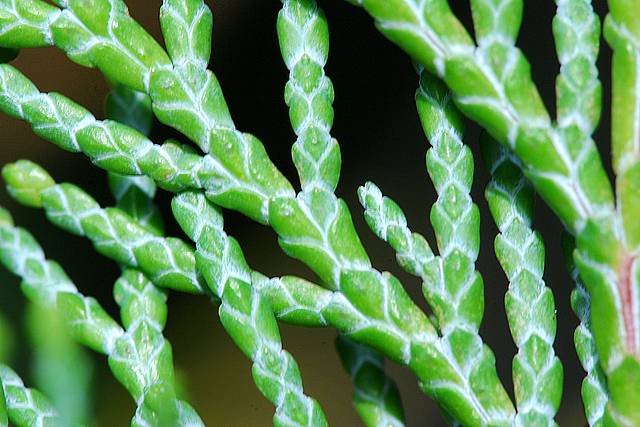Chamaecyparis lawsoniana
 Port Orford cedar
Port Orford cedar

Known as a splendid timber tree growing close to 100 feet high on the Oregon–California border, it is, surprisingly, available in the form of ornamental cultivars that range in height down to 3 feet. The tall trees are the principal source of shingles and shakes in California. As siding it is cheaper than redwood but less durable. The closets of older campus homes are invariably lined with cedar, so as to repel clothes moths; the aromatic fragrance is a warning to insects.
Several other species of Chamaecyparis occur in Japan and Taiwan, and are adaptable to bonsai treatment. They have contributed to the dozens of available cultivars. Chamaecyparis is closely related to the cypress (-cyparis is just a spelling variant of cypress), but differs by displaying its twigs as flattened sprays covered with tiny stem-clasping scales and by dropping its cones annually. The prefix chamae- is borrowed from an ancient Greek word chamaidrus meaning a stunted tree. The word drus taken on its own meant tree; in fact English tree and Greek drus have a common origin.
The fungus Phytophthora lateralis has been killing Port Orford cedars in Oregon. The related P. ramorum, which causes sudden oak death, was also reported on a redwood in 2002. The Irish potato blight reminds us of the social consequences of Phytophthora.
Ray Collett writes that the Port Orford cedar “bears foliage that is pungently fragrant and rather sourish. The wood… smells sweet, something like a rose!” (Pacific Horticulture, 67,4, 2006, p. 6.) There are several, old and new, at Kingscote Gardens, including two narrow old specimens near the pond. In Palo Alto, see a specimen to the right of the front door at 1127 Hopkins Avenue, and the remnants of an old row southeast of the building at the Palo Alto Lawn Bowls Club (474 Embarcadero Rd). A magnificent specimen stands on the right at 1240 Arbor Road in Menlo Park.
Name derivation: Chamaecyparis – Gk. chamai (low growing) and kuparissos (cypress); lawsoniana – Charles Lawson (d. 1874), Scottish nurseryman who raised it from the original introduction in Great Britain in 1854.
About this Entry: The main text of this entry is from the book Trees of Stanford and Environs, by Ronald Bracewell, published 2005. John Rawlings added the Pac Hort quote and removed Japan as being part of the native range (an error in the book). Phytophthora, fragrance, and genus notes edited; grove at 776 Dolores Street not found (many incense cedars are clustered there, however); gold-leaf variety at 1133 Harker Avenue on the left side was removed around 2012; added Palo Alto and Menlo Park locations (May 2024, SP).





